Stolen clock, message in a bottle some of the Easter eggs at Michigan Central Station
A stolen clock continues to captivate crowds.
It's the timepiece that once hung on the Detroit train station built in 1913, returned by a thief shortly after Ford Motor Co. purchased Michigan Central Station.
The station had been abandoned for three decades. The act of kindness went viral. The clock was left by an abandoned building, wrapped in a blanket and the subject of an anonymous call to The Henry Ford Museum (and, later, text to the automaker) for pickup.
Thief: "I only have the clock. No other material. I left it leaning against a burned-out building on Lawton. It is between Warren and Buchanan. The building is between the train tracks and 4470 Lawton. Please send two men and a truck immediately. It has been missing for over 20 years and is ready to go home. Thank you so much."
Ford Land: "Thank you! I will try to send a crew right now."
Thief: "Please have them lay it face up in the truck. The paint is very delicate. You can tell the front from the back by looking at the exposed legs."
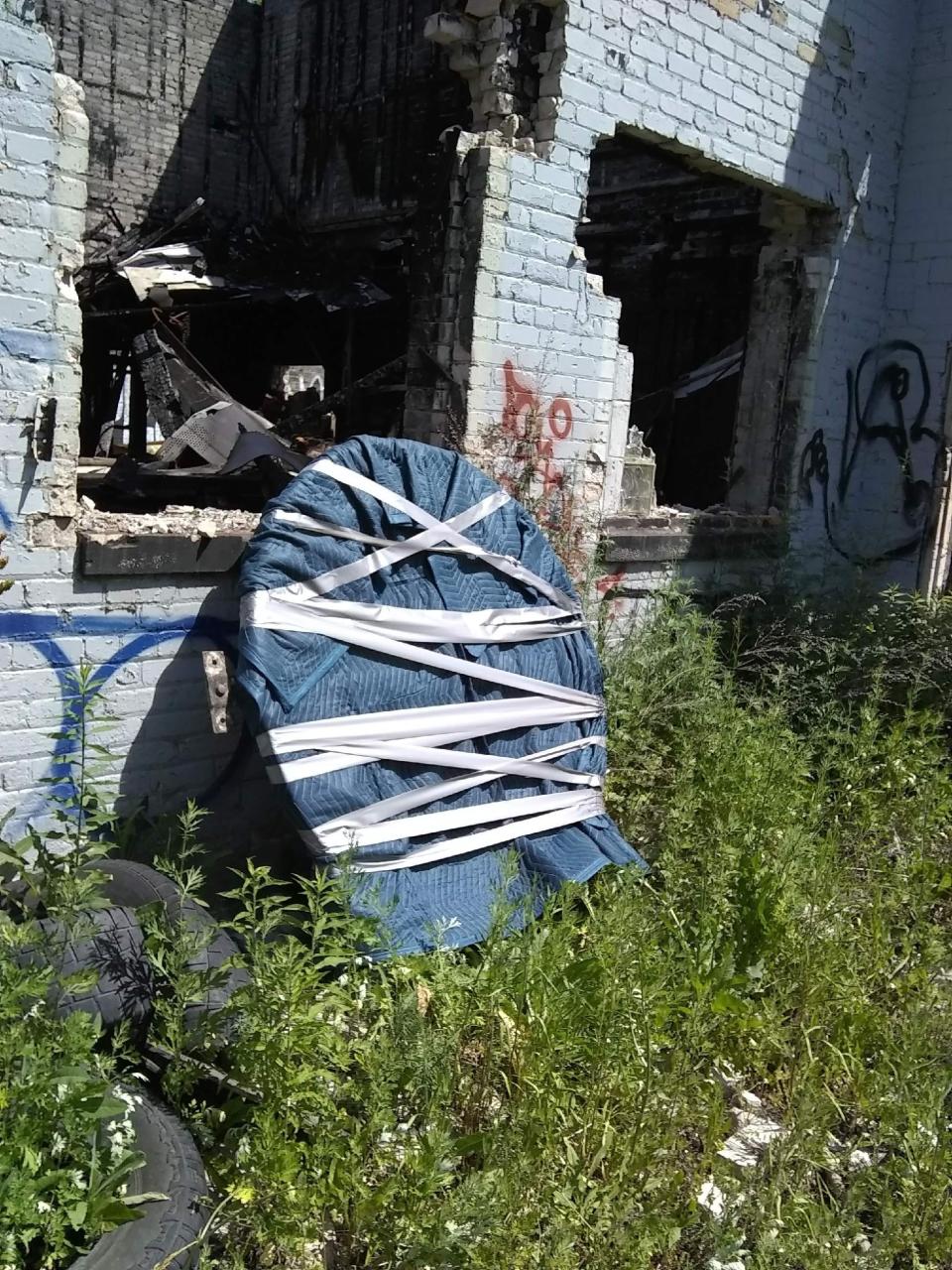
It was left just 2 miles from the depot in a low-activity area north of Corktown that includes Bargain Office Equipment and Faithful Mount Triumph Baptist Church.
The clock is one of hundreds of antiques and decorative parts stolen from the 18-story Beaux Arts structure, which was listed on the National Register of Historic Places in 1975.
And America celebrated a thief who displayed a bit of civic responsibility.
Yet time can change how we see things, including the stolen clock scenario.
"I don’t like to refer to it as having been stolen because the Detroiter who took the clock did so in order to protect it from being melted down for scrap and preserved it," said Dan Austin, communications director at Michigan Central. "In many ways, he didn’t steal it; he saved it. Had it not been for him, we would not have it today. And we would not be able to return it to the carriage house,"
He hated referring to the man who returned the carriage house clock as a thief.
"As a preservationist," said Austin, who runs the historicdetroit.org website, "he’s a hero to me and not a thief."
While the man returned the clock anonymously, a member of the Michigan Central community engagement team later revealed knowing the person. Ford actually reached out to celebrate his generosity but the man declined and requested to remain anonymous, Austin said.
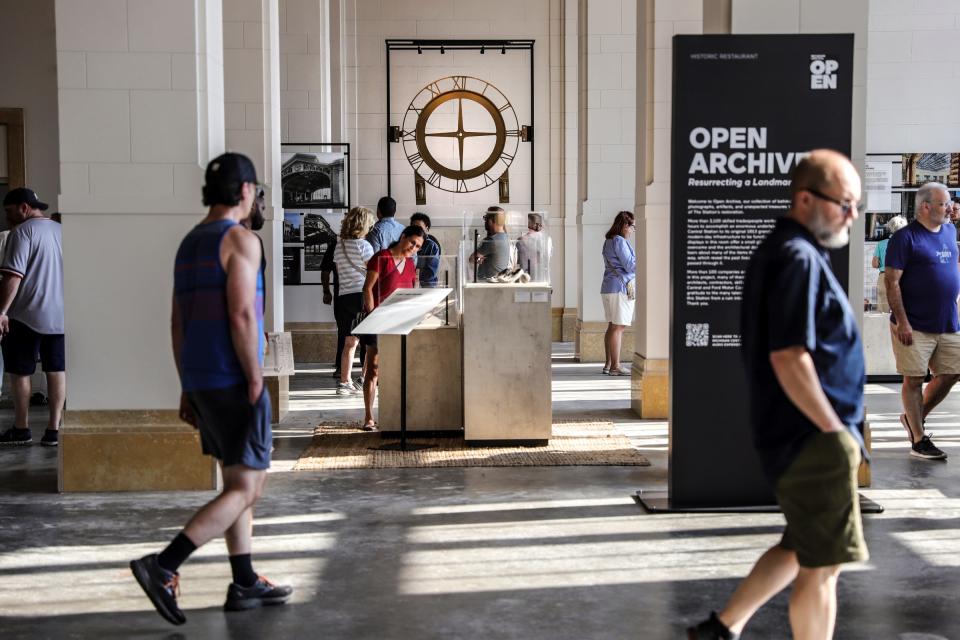
Eventually, the clock will be installed again on the exterior of the renovated former train station.
But that's not the only Easter egg at Michigan Central as visitors pour through the grand halls that once shipped soldiers to war and later welcomed them home.
An empty beer bottle wrapped in mystery
There's a message in a bottle from 1913 discovered during demolition of the historic reading room. While finding old beer bottles and cigarette tins stuck behind the crumbling plaster walls was not unusual for restoration workers, the bottle of Stroh's Bohemian Beer had a handwritten note inside. It was among more than 200 items found from more than a century ago and collected.
Stephanee Borger, 41, of Oak Park, and Adam Sekuler, 46, of Detroit, stopped Friday night to take a closer look of the “Message in the Bottle,” while touring the first floor of the Michigan Central Station for the “Summer at the Station” self-guided tours.
“We’re trying to make out the indecipherable word,” Sekuler said. “It’s interesting, in general, the ways people left treasures in the building. You get to kind of make up your own narrative.”
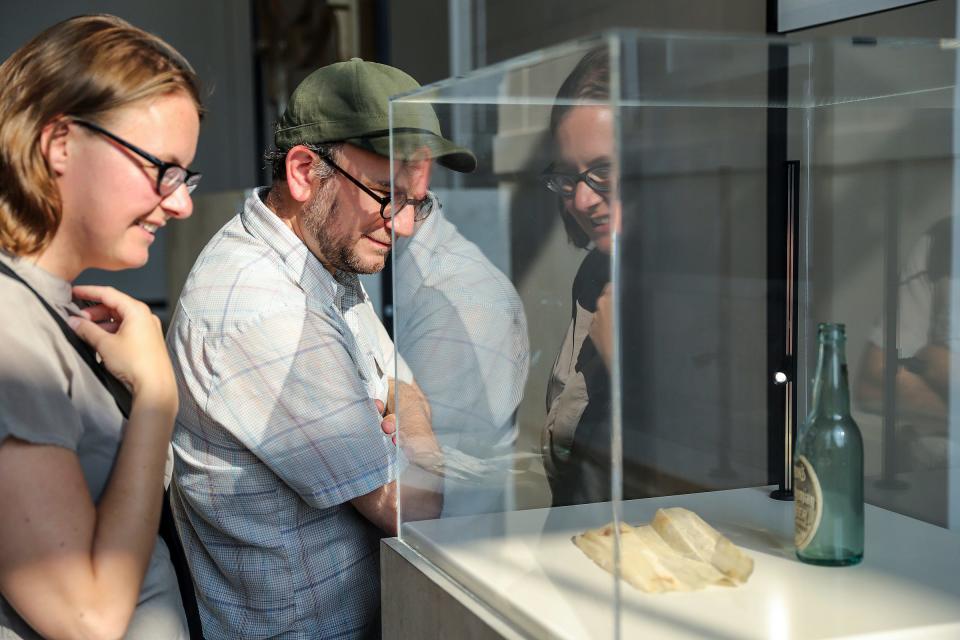
Learning of the found artifacts impressed Borger.
“The fact that they even had the thought to preserve and look inside the bottle is something that probably would not have happened anywhere else but Detroit," Borger said.
The pair continued to talk about how the items on display made the opening of Michigan Central Station more than just about restoration of the building, but more about reconstructing and connecting them to the past and how special that makes Detroit. Leaving graffiti in areas of the iconic building, though controversial to some, is also about honoring the past, Ford said.
Lost, ruined, scrapped
Jeremy Dimick, manager of collections at the Detroit Historical Society, said in 2018 that it's encouraging to see a building that meant so much to so many "go from being unused and unwanted for so long come back and find a second life."
"This building is priceless," he said. "And a lot of times, when things disappear, they never resurface. They're lost, ruined, scrapped. Just the fact that this clock survived is incredible."
A ticket to ride
Another tiny treasure on display is a collection of old train tickets found during renovation.
"They had just been stuffed into walls and the ceiling and maybe used as insulation or something," Austin said. "Back in the day, there was an unsheltered individual named 'Catfish' living there. I was told he would use the tickets as bedding, and he would sell tickets to people. But there were still more in the station after the resurrection began."
Mention of Catfish has come up during interviews repeatedly with people familiar with the site. The Free Press learned that the man was able to buy back his childhood home, but he's struggling to meet city code requirements related to extreme disrepair. Catfish reportedly used money collected from various sources including bottle returns to buy the home off West Grand Avenue, and Detroit officials are working with him. Distressed homes in Detroit can still be found for less than $10,000.
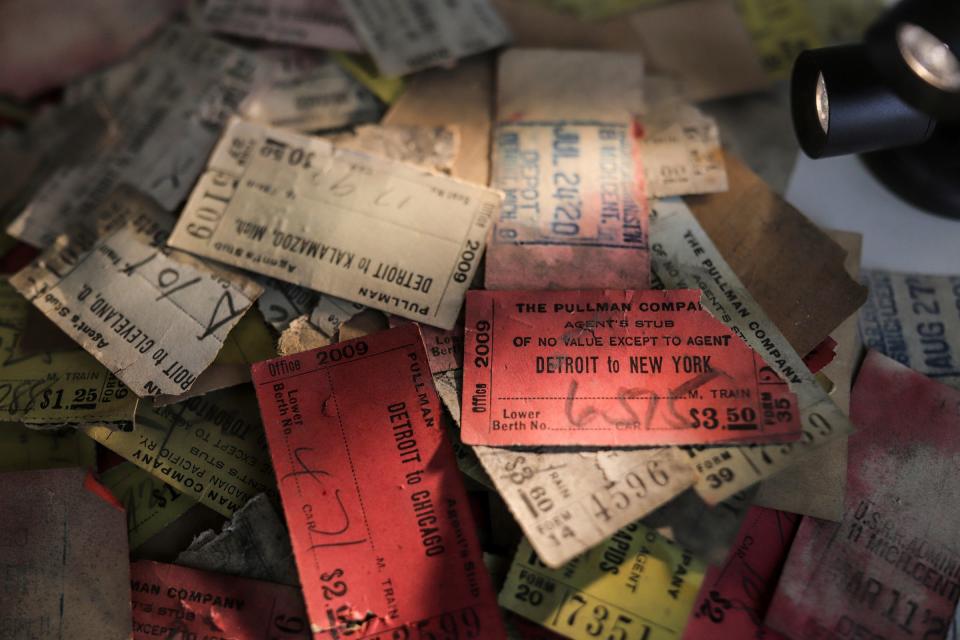
So many colorful pieces of paper, old train tickets, were found in the ticket lobby ceiling as Ford crews dismantled an unsafe portion of what was left of the building, said Austin Giesey, project manager responsible for the interior historic finishes for the Christman/Brinker Corktown Joint Venture.
"They didn’t expect to find artifacts while carefully dismantling the ceiling," he said. "Soon after, one of the crew members saw a ticket that found its way like a feather to the ground. These are actual tickets of passengers going to Cleveland, New York, Chicago. We found hundreds of them," he said, also mentioning the presence of someone living in the building at the time.
The restoration team holds campaigns on restoration projects that include signs that say,"Don't pocket the past." And workers helped put together a collection of treasures now archived by Ford.
A ram's head is recreated
When Ford bought Michigan Central in 2018, the company knew something ornate went on the tops of the rectangular columns known as pilasters in the once-elegant tea and reading room with windows overlooking Michigan Avenue and the Vernor Viaduct. The room had so deteriorated after years of being exposed to rain and snow and cold and heat, and no known historical photos existed for restoration guidance, Austin said.
Antique collector Terry Fadina in Detroit came forward and told Ford that there were ram's heads in the room. And he loaned one to Ford to make 3D digital scans with a handheld device.
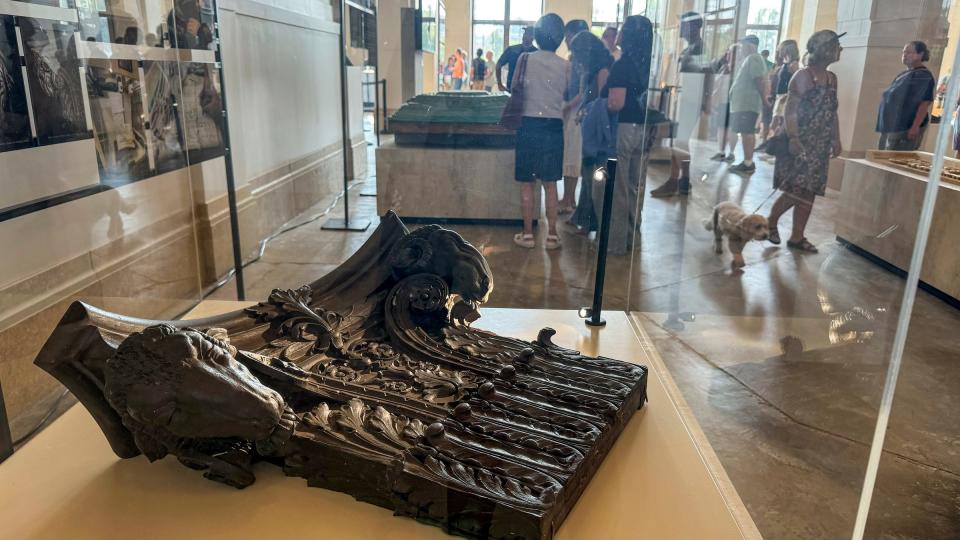
After a specialist adjusted the digital file to correct for any errors and the wear related to age, they made several prototypes, said Ford spokesman Dan Barbossa.
Restoration workers made an impression of the ram's head pieces for a silicone mold, which allowed the casting of final pieces in plaster, Barbossa said. These were painted by hand on-site to mimic the original pieces.
"What they did back in the day in the United States, they would often use plaster that was painted to look like wood or stone in places people couldn’t touch as a cost-saving move," Austin said. "If you look at top of the waiting room, what's the Grand Hall now, it’s actually plaster and not stone up there."

In photos from when the station was vacant — "ruin porn" widely viewed as a national symbol of Detroit's diminished stature — the half-moon windows were surrounded just by brick. Moisture caused the plaster to disintegrate.
"It would’ve taken a lot of time and money to have somebody hand carve all those column capitals," Austin said. It was far cheaper and uniform to have a sculptor sculpt one (ram's head) out of clay, make a plaster mold from that and paint them to look like wood."
Fadina, who told the Free Press that the original ram's head is hanging on his living room wall in Detroit, said working with Ford on the project was "kind of a miracle."
The Ford team had known that there was special trim above the wainscoting in this room, but historic drawings lacked detail to provide needed direction, and historic photography was also not clear enough. With the ram’s heads in hand, the drawings and photos were enough to verify that this piece was from the room, Ford told the Free Press. Ford then approved a change order that would allow the team to devote resources to re-creating these pieces.
A Sherlock Holmes investigation team at Ford
Giesey worked with the team to hunt down missing pieces of the abandoned train station, antique pieces that had been scavenged and sold.
“Early in 2021, Terry showed up with the ornament. The ‘aha’ moment was the ram’s head. We wanted to make sure we documented the piece. This was incredible,” Giesey said. “All credit to Terry for having it.”
At times, Giesey sounded like a Sherlock Holmes when talking about the hunt for items all across the U.S. The process toward restoration, including something as basic as re-keying all the temporary doors, brought people into the station who knew people who knew people who helped in the search.
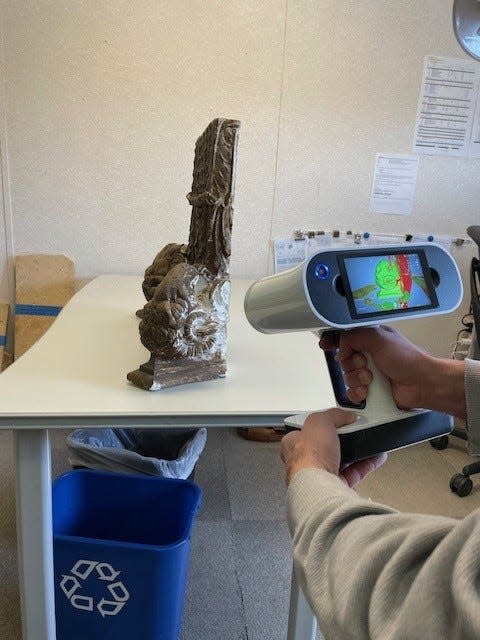
Ford connected with a wealthy man in Maine who owned ornate Mankato limestone from above a doorway in the Grand Hall, and that has been used for re-creation. Ford flew Giesey's team out east to laser scan the items.
Open weekends now
The interior of the building on Michigan Avenue in Corktown, the city's oldest surviving neighborhood, has been renovated. Big plans remain for parts of the exterior and park that will be part of the 30-acre campus in southwest Detroit. The $950 million architectural restoration and renovation, which includes Michigan Central and other buildings (such as the abandoned Detroit Public Schools Book Depository now known as Newlab), has stunned visitors since the grand reopening on June 6.
Within the first 10 days of opening to the public, more than 65,000 people were counted coming through the doors of Michigan Central, Austin said. When free tickets became available online, the surge in activity initially crashed the system.
On Friday, the first day of the first weekend open to the public, 737 visitors entered within the first 50 minutes, Austin said. Now the station is open from 5 p.m. to 9 p.m. on Fridays and from 10 a.m. to 5 p.m. on Saturdays through August. Tickets are not required. However, the depot will be closed July 5-6. The site is not open to the public during the week.
Ford CEO Jim Farley has characterized the architectural miracle as something that feels like sweet revenge on longtime critics who failed to believe in the potential of the city.
Henry Ford reportedly had hoped to develop the Corktown area but his plans were disrupted by the Great Depression. Irish immigrants settled the area named for County Cork, Ireland, which the Ford family visits to celebrate their heritage and an early auto plant.
Now Bill Ford, executive chair of the company founded in 1903 and great-grandson of the founder, has fulfilled the family dream.
More: Childhood memories of Detroit explain emotion of Michigan Central Station opening
More: Michigan Central Station: How secret basement, flooding nightmare led to renovation delays
Editor's Note: The reporter's husband worked on the train station as an electrician employed by Conti. And her great-great grandfather founded T.J. Wall & Sons paint company in Corktown in the 1800s.
Contact Phoebe Wall Howard: 313-618-1034 or [email protected]. Follow her on X, formerly known as Twitter, @phoebesaid. Read more on Ford and sign up for our autos newsletter.
This article originally appeared on Detroit Free Press: Michigan Central Station in Detroit full of Easter eggs like clock
Solve the daily Crossword

